Japan
Wood Products Prices
Dollar Exchange Rates of 25th
Apr
2022
Japan Yen 129.9
Reports From Japan
Rising raw material prices and
currency depreciation a
risk to economy
The government has upgraded its economic assessment for
the first time in four months citing a recovery in private
consumption as the effects of the coronavirus pandemic
wane. The recovery has been driven by more spending on
travel and dining out.
The Cabinet report says:
¡°Concerning short-term prospects, the economy is
expected to show movements of picking up supported by
the effects of the policies and improvement in overseas
economies while taking all possible measures against
infectious diseases and economic and social activities
move toward normalisation. However, full attention
should be given to the further increase in downside risks
due to rising raw material prices and fluctuations in the
financial and capital markets and supply-side constraints
while the uncertainties surrounding the state of affairs of
Ukraine. Also attention should be given to the effects of
the Novel Coronavirus.¡±
See:
https://www5.cao.go.jp/keizai3/getsurei-e/2022apr.html
In related news, Ranil Salgado the head of the IMF
mission in Japan, has said the yen's rapid recent
weakening against the US dollar could interrupt recovery
of the Japanese economy as the cost of imports are rising
which is undermining consumer spending.
The yen's drop to a 20-year low against the dollar at the
end of April is closely related to the Bank of Japan's
decision to maintain the monetary easing policy when
central banks in other major economies are tightening.
A weaker yen typically serves as a boon to Japanese
exporters as Japan-made products become more
competitively priced overseas but now, with the cost of
imports especially energy sources rising, consumers have
seen sharp increases in daily goods. Japan¡¯s consumer
price index, excluding volatile fresh food, rose almost 1%
March from a year earlier, the fastest increase in over two
years.
Shunichi Suzuki, the Minister for Economy and Finance
said the rapidly weakening yen could cause problems for
Japan's economy and the media have speculated that, for
the first time in over 20 years, the government may try and
slow the rate of depreciation.
See:
https://japantoday.com/category/business/imf-says-yen'srapid-slide-may-hamper-japan's-post-pandemic-recovery
Firm housing starts
Housing starts unexpectedly rose by 6% year-on-year in
March 2022 exceeding expectations. The March rise
builds on the increase seen a month earlier.
A statistical survey of housing starts for 2021 from the
Ministry of Land, Infrastructure, Transport and
Tourism (MLIT) shows the number of new housing starts
in 2021 was 865,909, up 6.6% from the previous year, the
first increase in three years. The floor area of new housing
also increased for the first time in three years. By category
of homes it was reported that the number of custom home
starts increased for the first time in three years.
See:
https://www.rethinktokyo.com/news/2022/04/29/japan-newhousing-starts-increase-first-time-three-years/1651198823
A direct online real estate purchase service launched
In Japan the real estate market is fragmented and
homeowners wishing to sell face many challenges such as
difficulty in determining the value of a property, high
agent fees and a process to conclude a sale which could
take over 6 months. These issues discourage existing home
sales which in Japan are around 15% compared to the 80%
typically seen in the US and the UK. To help home sellers
a Tokyo ¡®proptech¡¯ startup offers a direct online real estate
purchase service.
See:https://techcrunch.com/2022/04/27/proptech-startupsumutasu-raises-10m-series-b-to-digitize-japans-real-estatemarket/
Energy-saving measures in the building sector
Japan has revised the Law on ¡®Improvement of Energy
Consumption Performance of Buildings to Contribute to
the Realisation of a Decarbonised Society¡¯. The revision
specifies energy-saving measures in the building sector in
order to achieve carbon neutrality by 2050 and a 46%
reduction in greenhouse gas emissions by 2030 compared
to 2013 levels.
To promote energy-saving renovations a low-interest loan
programme for residential properties will be established by
the Japan Housing Finance Agency.
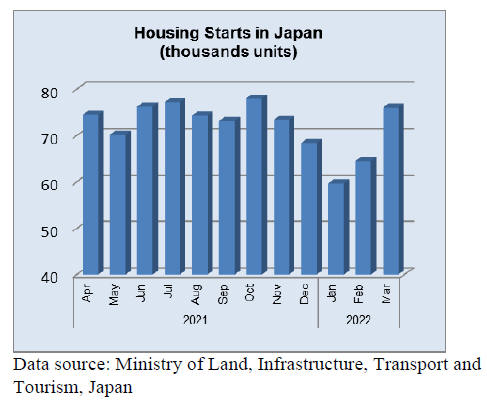
Sawnwood prices at record highs
Sawnwood prices have reached record highs in Japan
since economic sanctions were imposed on Russia and this
will push up the cost of new homes. Russia accounted for
around 80% of Japan¡¯s imports of veneer for plywood
production and about 20% of Japan¡¯s imports of roof
timbers came from Russia.
The Bank of Japan¡¯s report on the corporate goods price
index for March, released on April 12, showed sawnwood
prices jumped nearly 60% recently.
See:
https://www.asahi.com/ajw/articles/14601984
Yen tumbles to 130 to the US dollar
For the first time since April 2002 the yen fell to 130
against the dollar on 28 April after the Bank of Japan
(BoJ) maintained its ultra-easy monetary policy at its latest
board meeting. This decision is in sharp contrast to the US
Federal Reserve that has raised interest rates.
At the two-day policy meeting at the end of April the BoJ
said it will purchase Japanese government bonds from
financial institutions to support the economy still
recovering from the impact of COVID-19.
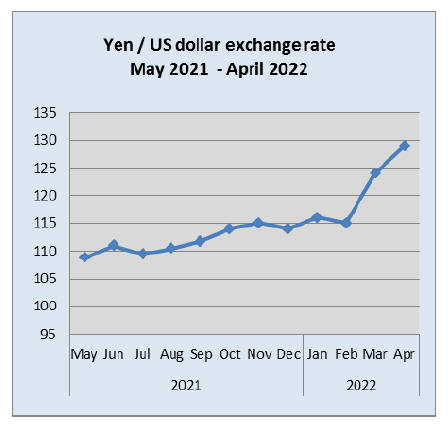
Import update
The Ministry of Finance has not released import data for
either wooden doors (HS448120) or wooden windows
(HS441810).
Assembled wooden flooring imports
There was a serious downward correction in the value of
Japan¡¯s imports of assembled flooring (HS441871-79) in
February. There had been a steady upward trend in the
import value between May to December 2021. Year on
year, assembled wooden flooring imports were up 5% in
February 2022 but the February figure was down by 18%
compared to January 2022.
The main category of assembled flooring imported by
Japan continues to be HS441875, accounting for around
70% of January 2022 imports with the main suppliers
being China, Vietnam and Malaysia. The second ranked
category in terms of value of imports was HS441879
shipped mainly from China, Thailand and Vietnam.
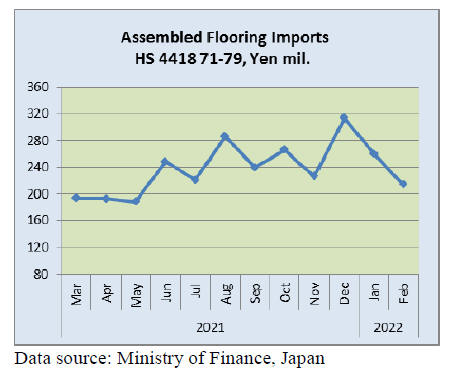
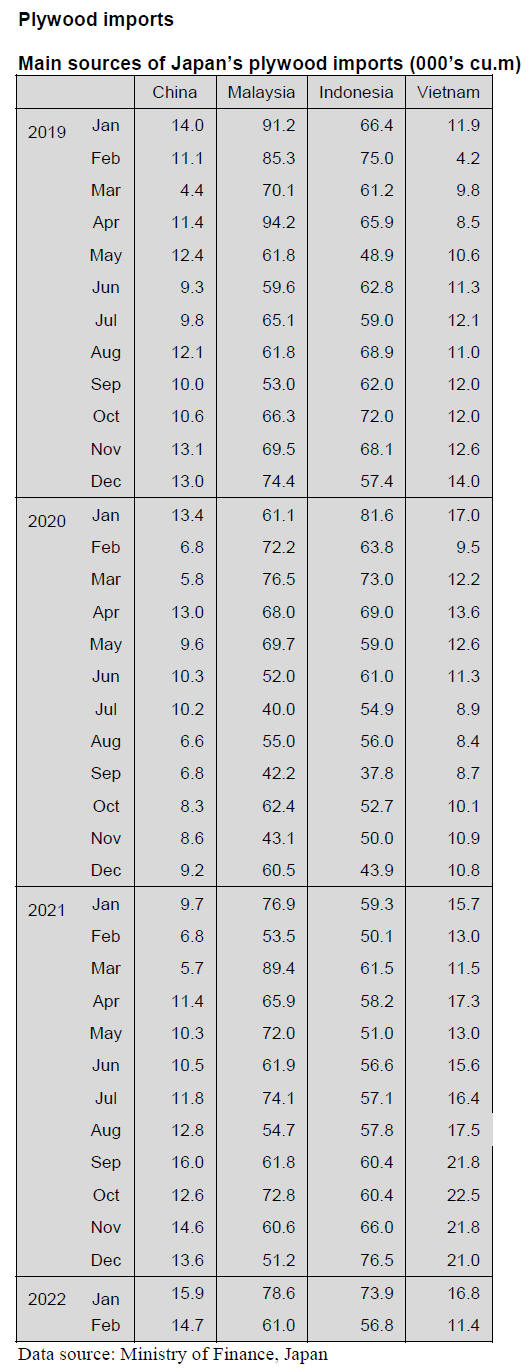
HS441231 was the most common accounting for 88% of
total plywood imports.
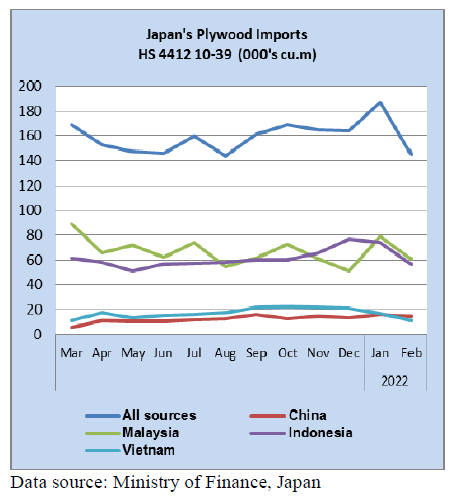
Malaysia and Indonesia were the main plywood
shippers
to Japan and in February 2022 shipments from Malaysia
rose year on year but were below the volume imported in
January. A similar pattern was seen for plywood imports
from Indonesia and China. It was only shippers in
Vietnam that managed year on year and month on month
increases in February 2022.
Trade news from the Japan Lumber Reports (JLR)
The Japan Lumber Reports (JLR), a subscription trade
journal published every two weeks in English, is
generously allowing the ITTO Tropical Timber Market
Report to reproduce news on the Japanese market
precisely as it appears in the JLR.
For the JLR report please see:
https://jfpj.jp/japan_lumber_reports/
Items of sanctions by the government
The Japanese government announced items of additional
sanctions to Russia on April 12. Russia banned export of
wood chip, veneer and logs for retaliation to the sanctions
by the unfriendly Western countries. Log export is banned
since beginning of this year so there is no influence.
According to the Forestry Agency, actual imported result
in 2 021 is 36,000 cbms of logs (900 million yen in value),
80,000 tonnes of wood chip (1.3 billion yen) and 244,000
cbms of veneer (8.5 billion yen).
Market share of wood chip is 1%, of veneer is 82%. As
raw materials to manufacture plywood in Japan, it takes
2% share. Larch veneer is used for face and back of
plywood and LVL because of the strength so plywood
mills in Japan need to find substitution in a hurry to
replace Russian supply.
February plywood supply
Total plywood supply in January was under 500,000 cbms.
Monthly volume of less than 500 M cbms is for the first
time in six months. This is because of the volume of
imported plywood was under 200,000 cbms. The volume
of domestic production and shipment in Japan are
balanced and the inventory at manufacturers is minimum.
The volume of imported plywood from Malaysia and
Indonesia both decreased. One of major plywood
manufacturers in Malaysia stopped taking new orders in
last November and put priority on orders which were
delayed for shipping. Manufacturers in Indonesia hurried
shipping order balances to Japan in February, 2022 after a
rush of shipping products to other countries completed
during October, 2021 to January, 2022. The volume of
Chinese plywood was influenced by a Chinese New
Year¡¯s holiday.
It is hard to predict the volume of imported plywood after
March. There are not enough logs and labors in Malaysia
and Indonesia so there will be less plywood supply for
Japan. The prices of logs in both countries are increasing
every month.
There is not enough imported plywood at markets in
Japan. People are careful to buy import plywood because
the prices are high in Malaysia and Indonesia and a sudden
weak yen hit against the dollar at the end of March.
The production of domestic softwood plywood exceeded
shipment a little bit. The production of domestic softwood
plywood is 78,300 cbms, 1,300 cbms more than last
month.
Manufacturers¡¯ inventory level is 0.3 month and this is
same inventory level as January. Usually, it is the time to
build up inventory in February to April by the
manufacturers but still there are not enough inventory due
to a shortage of logs and a delay of delivery. February had
only eighteen working days and it affected lower
production.
It is important to see the balance of demand, product and
supply in April because Russian veneer was prohibited
exporting to Japan at the begging of March. This takes
considerable part of domestic plywood and lack of
imported veneer would reduce total plywood production.
South Sea logs and lumber
Supply of South Sea hardwood logs is low even after rainy
season is over in producing regions. Demand for South
Sea hardwood logs in Japan is way down after all the
plywood mills stopped using tropical hardwood logs and
only demand is for lumber of truck body.
Production of trucks is slowing by shortage of
semiconductor then in March some major truck
manufacturer lost certificate on engine by illegal
procedures so truck production would decrease in coming
months so demand for truck body lumber would also
decline.
Supply and demand of tropical hardwood lumber
manufactured in China are balancing. Dealers in Japan
have ample inventory of free board but some place orders
hurriedly as weak yen would push the import cost. In
China, severe measure is taken to stop spreading COVID
19 like lockdown of communities and transportation is
being disrupted.
Wood use for public buildings
Wood use promotion office by the Ministry of Agriculture,
Forestry and Fisheries announced actual wood use by the
public buildings in 2020. Total of 154 units of buildings
lower than three stories were built, out of which 132 units
are wooden building. Percentage of wooden building is
85.7%. This is two straight years with more than 85%.
As number of unit, total is almost doubled to 2019 but
floor space per unit is smaller than 2019 so total floor
space is 13,861 square meters, only 1.2% up from 2019.
Wood use for interior is 220 units, 66.7% more, first
increase in four years. Total volume of wood is 5,286
cbms, 1.6% less because of many small size buildings.
This is two straight year¡¯s of over 5,000 cbms of wood
use. 3,790 cbms of wood used is domestic wood. Units
with large floor space are roadside stations, where local
products are sold for visitors.
This is managed by the Ministry of Land, Infrastructure,
Transport and Tourism. One has floor space of 1,144
square meters and another has 515 square meters. Other
small units are bicycle storage and interior passage of Diet
building. Also explosive warehouse for the Defense
Ministry was built with wood for three consecutive years.
The Forestry Agency and The Ministry of Land,
Infrastructure, Transport and Tourism inspected on 22
non-wood buildings if any can be built with wood. Only
six units can be built with wood.
|